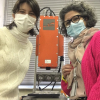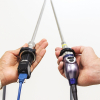A project, involving Nottingham Trent University and global infrastructure consultancy Opus International Consultants, could save tens of millions of pounds a year in surveying costs and remove the need for potentially dangerous inspections. The three-year project involves the creation of a remote imaging system which simultaneously performs both 3D and spectral imaging, providing important information about the physical and chemical characteristics of the structure. It will help to inform crucial decisions about when to repair or decommission structures including bridges, footbridges, pylons, culverts, station canopies, roof structures and tunnel linings.
The “RustScan” instrument and accompanying “RustDetect”" software—which will be used via hand-held or tripod-mounted cameras or even drones—will be able to generate detailed data regarding surface blistering and corrosion. The tools will have widespread application for all structures where metal is an integral part of their construction, particularly where safety is paramount and failure would be catastrophic. The information will help to build up a 3D model of the structure’s condition, which will be used to identify areas requiring immediate attention, maintenance programmes and lifespan modelling.
Surveying and monitoring of steel structures such as bridges is an extremely laborious process, with inspections frequently requiring people to scale or access hard-to-reach places, which can be time-consuming, expensive and dangerous. Many bridges in the UK date back to the Victorian era and require careful management. The project builds on previous Nottingham Trent University research, which resulted in the development of a remote spectral imaging system for the examination of large-scale wall paintings, revealing the composition and degradation of paints that were used, as well as hidden details not visible to the naked eye. Red ochre, a natural earth pigment used to make paint, is made up of the same chemical ingredient as rust—iron oxide.
“There is currently no technology that combines 3D and spectral imaging in one instrument in this way”, said Professor Haida Liang, Head of the Imaging & Sensing for Archaeology, Art History & Conservation research group at Nottingham Trent University.
Professor Liang, who is based in the University’s School of Science and Technology, added: “It is fascinating to see that an instrument previously funded for the protection and understanding of historic wall paintings will now make an impact on this industry. Remote simultaneous 3D and spectral imaging will provide direct identification of surface rust and corrosion. The technology will also be able to provide a time-specific record of the condition of the bridge for future comparison with later scans, in addition to assisting in the development of an appropriate maintenance programme for the bridge.”
James Hulme, part of Opus International Consultants’ UK Leadership Team, said: “We are extremely excited about this new work, which could provide a major industry impact for years to come. Our clients continually look to us for planning, design, maintenance and management of structures such as bridges, viaducts and pylons. We are always looking for new technologies which offer cost-effective solutions to safely defer expensive upgrades or replacements that may not actually be required. Industry is keen to make more of what already exists rather than keep building new structures, which can impact upon the environment, health, safety and budgets. Surveying of bridges is currently an extremely laborious process and much of it is carried out manually. We need technology that circumvents the need for people putting themselves in these potentially dangerous positions.”










